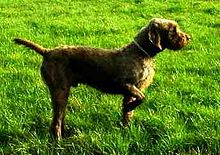| Revision as of 23:08, 13 January 2006 editTrysha (talk | contribs)Extended confirmed users3,768 edits convert table to infobox dogbreed← Previous edit | Revision as of 23:19, 20 March 2006 edit undoFloridan (talk | contribs)Extended confirmed users992 editsm →History: Pudel to poodleNext edit → | ||
| Line 23: | Line 23: | ||
| == History == | == History == | ||
| In ], a German breeder, Baron von Zedlitz, worked on producing his ideal tracking, pointing, and retrieving ], suitable for work on both land and water. From seven specific |
In ], a German breeder, Baron von Zedlitz, worked on producing his ideal tracking, pointing, and retrieving ], suitable for work on both land and water. From seven specific ]s (pudel in german) and nearly 100 different pointers, he developed the pudelpointer. The original sire was '''Tell''', an English pointer belonging to ] and the original dam was a German hunting pudel named '''Molly''' who was owned by ], an author known for works on hunting dogs. | ||
| The goal was to produce a dog that was willing and easy to train, intelligent, and loved water and retrieving, like the |
The goal was to produce a dog that was willing and easy to train, intelligent, and loved water and retrieving, like the poodle, and add to that a great desire to hunt, a strong pointing instinct, and an excellent nose, like in the ]. | ||
| The |
The poodle breed had much stronger genes, and so many more Pointers were used to achieve the balanced hunting dog that was desired. A mix of 11 Pudels and 80 Pointers was used during the first 30 years. | ||
| The breed was introduced to North America in ] by ], who still today remains very involved in maintaining the breed standard. His ] was the foundation of the breed in North America. In ] Winterhelt founded the Pudelpointer Club of North America in ]. | The breed was introduced to North America in ] by ], who still today remains very involved in maintaining the breed standard. His ] was the foundation of the breed in North America. In ] Winterhelt founded the Pudelpointer Club of North America in ]. | ||
| Although it is an excellent breed with no major faults, it has never become a popular or well-known breed. In Germany, its performance standards are its most important traits and each dog must pass a test of its field skills to be registered as a |
Although it is an excellent breed with no major faults, it has never become a popular or well-known breed. In Germany, its performance standards are its most important traits and each dog must pass a test of its field skills to be registered as a pudelpointer. | ||
| == External links == | == External links == | ||
Revision as of 23:19, 20 March 2006
Dog breed| Pudelpointer | |||||||||
|---|---|---|---|---|---|---|---|---|---|
 Pudelpointer pointing Pudelpointer pointing | |||||||||
| Origin | Germany | ||||||||
| |||||||||
| Dog (domestic dog) | |||||||||
A Pudelpointer is a versatile hunting dog breed from Germany. They are a pointing breed that came from a cross between poodles and the English Pointer.
Appearance
The breed weighs between 44 and 66 pounds (20-30 kg), stands 21 to 26 inches (53-66 cm) at the shoulder, and comes in liver, chestnut, and occasionally black coats. The ideal coat is harsh, wiry, and dense.
History
In 1881, a German breeder, Baron von Zedlitz, worked on producing his ideal tracking, pointing, and retrieving gun dog, suitable for work on both land and water. From seven specific Poodles (pudel in german) and nearly 100 different pointers, he developed the pudelpointer. The original sire was Tell, an English pointer belonging to Kaiser Frederick III and the original dam was a German hunting pudel named Molly who was owned by Hegewald, an author known for works on hunting dogs.
The goal was to produce a dog that was willing and easy to train, intelligent, and loved water and retrieving, like the poodle, and add to that a great desire to hunt, a strong pointing instinct, and an excellent nose, like in the English pointer.
The poodle breed had much stronger genes, and so many more Pointers were used to achieve the balanced hunting dog that was desired. A mix of 11 Pudels and 80 Pointers was used during the first 30 years.
The breed was introduced to North America in 1956 by Bodo Winterhelt, who still today remains very involved in maintaining the breed standard. His Winterhelle Kennel was the foundation of the breed in North America. In 1977 Winterhelt founded the Pudelpointer Club of North America in Canada.
Although it is an excellent breed with no major faults, it has never become a popular or well-known breed. In Germany, its performance standards are its most important traits and each dog must pass a test of its field skills to be registered as a pudelpointer.
External links
- Official website for the Pudelpointer Club of North America
- Canadian American Pudelpointer Association
- Yahoo Pudelpointer group